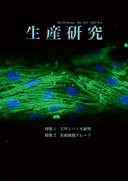Volume 67, Issue 3
Displaying 1-12 of 12 articles from this issue
- |<
- <
- 1
- >
- >|
Introduction to Special Section
-
2015 Volume 67 Issue 3 Pages 245
Published: May 01, 2015
Released on J-STAGE: June 05, 2015
Download PDF (229K)
Research Flash
-
2015 Volume 67 Issue 3 Pages 247-249
Published: May 01, 2015
Released on J-STAGE: June 05, 2015
Download PDF (548K) -
2015 Volume 67 Issue 3 Pages 251-253
Published: May 01, 2015
Released on J-STAGE: June 05, 2015
Download PDF (830K) -
2015 Volume 67 Issue 3 Pages 255-257
Published: May 01, 2015
Released on J-STAGE: June 05, 2015
Download PDF (425K)
Research Review
-
2015 Volume 67 Issue 3 Pages 259-264
Published: May 01, 2015
Released on J-STAGE: June 05, 2015
Download PDF (1060K) -
2015 Volume 67 Issue 3 Pages 265-272
Published: May 01, 2015
Released on J-STAGE: June 05, 2015
Download PDF (1539K)
Introduction to Special Section
-
2015 Volume 67 Issue 3 Pages 273
Published: May 01, 2015
Released on J-STAGE: June 05, 2015
Download PDF (119K)
Research Review
-
2015 Volume 67 Issue 3 Pages 275-279
Published: May 01, 2015
Released on J-STAGE: June 05, 2015
Download PDF (804K)
Research Flash
-
2015 Volume 67 Issue 3 Pages 281-285
Published: May 01, 2015
Released on J-STAGE: June 05, 2015
Download PDF (462K)
Research Review
-
2015 Volume 67 Issue 3 Pages 287-292
Published: May 01, 2015
Released on J-STAGE: June 05, 2015
Download PDF (798K) -
2015 Volume 67 Issue 3 Pages 293-296
Published: May 01, 2015
Released on J-STAGE: June 05, 2015
Download PDF (892K)
Research Flash
-
2015 Volume 67 Issue 3 Pages 297-300
Published: May 01, 2015
Released on J-STAGE: June 05, 2015
Download PDF (782K)
- |<
- <
- 1
- >
- >|
